In The Lore Explainer, we take a deep look at the lore behind our favorite games, movies, and books, and talk about the story behind them and sum up what you need to know and how you can find out more. Today we’re talking about the lore behind one of the most important characters in the lore of Warhammer 40k – The Emperor himself.
If there’s one character at the heart of 40k (and also the Horus Heresy), it’s a rotting corpse entombed on a golden throne. The Emperor is the defining reality of the 41st millennium, the central fulcrum around which all else turns. Billions fight and die in his name, the greatest evil of the galaxy wants nothing more than his final death and even the factions that aren’t really all that interested in whatever is going on on Terra are relentlessly attacked by the adherents of his murderous, psychopathic, fascist, cult – the Imperium of Man.
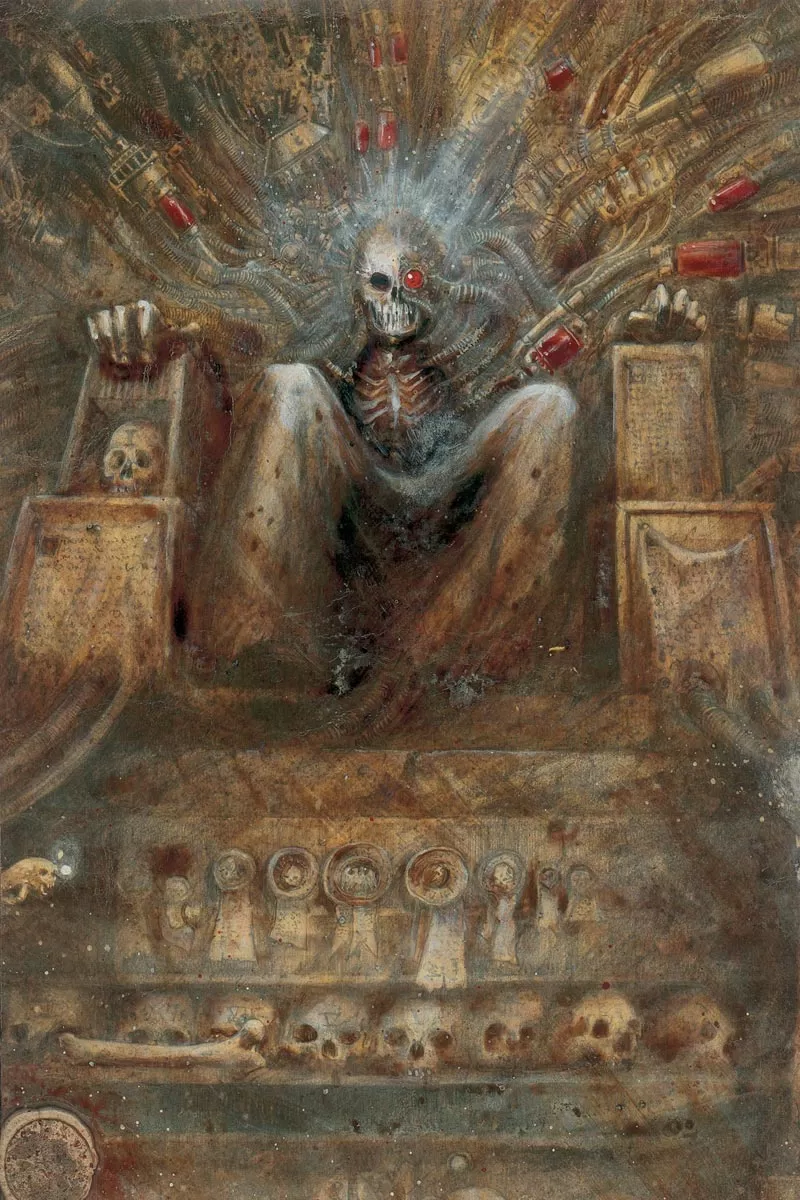
The facts of who the Emperor is, where he comes from, and what the hell he’s up to are all shrouded not just in mystery but in deliberate obfuscation, both within the universe of 40k and by the authors who’ve written about him. There may well be no single explanation, no one answer to anything about the Emperor, so we’ll get this straight right at the beginning – much of this is going to contradict itself. The Emperor is the ultimate enigma of, and the least reliable narrator in, the lore – so let’s have a look at what we know and – much more importantly – what we don’t.
This article contains spoilers for Horus Heresy novels, in particular The End and the Death.
This article contains images of human remains.
Note: I was, once, an Archaeologist and, at another time, a Historian. The Emperor is not a real guy – at least as far as we know – and the reasons he is written the way he is are situated in our world, not the Warhammer universe. There’s a lot of out-of-universe stuff in here, which has the “Note” tag attached to it. Having said that, he could be causing me to write this – how’s that for some hypodiegetic lore, eh?
Origins
Pinpointing what the Emperor actually is requires understanding where he comes from and even here at the very basic level of information, we have multiple conflicting origins. It’s hard to say exactly what’s “canon” about the Emperor, as the most recent depictions of him in the Heresy (those that elements of the community have deemed canon) come from his own telling – and if the emperor is anything, it’s that he’s a secret keeper. That, or just an outright liar. Older, more heretical sources have the Emperor as a magical experiment of sorts, the residue of humanity’s first psykers. As humanity grew and spread from scattered groups into a collection of bustling conurbations around the world (in what was once called the “Neolithic revolution”), their psychic presence began to stir the warp and draw the notice of the still-forming (or eternally present – depends who you ask) forces that would one day become the chaos gods. These foul, demonic, forces preyed upon the first of humanity’s psykers, once happily able to reincarnate at will, allowing them to shepherd our ancestors through dark and terrifying days. As our numbers grew, so did the power of the warp and the shamans found their abilities drawing demons to them like moths to a flame. Out of desperation, out of hope, or out of a misguided sense that what humanity really needs is a boot on its neck (despite all evidence to the contrary), they resolved to create a single being strong enough to be humanity’s bastion against the all-corrupting power of the warp – The New Man – the Emperor.
The mages, shamans, wise men and women and the myriad other human forms our burgeoning psychic powers took travelled to a conference somewhere – but let’s for no evidenced reason, beyond the fact that I like it, tie it to Catalhoyuk, an absolutely stunning archaeological site and surprisingly large town of the period. Wherever they met, they decided to pool their souls to create a weapon against Chaos and committed collective suicide. Instead of being torn apart in the warp this mass sacrifice welded their individually weak human souls together into a blazing conflagration, refashioning the guides of humanity into a spiritual equivalent of a self-aware nuclear bomb. The Anathema – the term used by Demons to refer to the Emperor – was born in the warp, a bright light amidst swirling, sentient darkness.
His human birth would come a year later, with a very clear (and not the last) Christ analogy – a human mother and father raising a God from a birth untrammelled by conventional human genetics. The child was born a psyker, and would grow powerful throughout his infancy. From the Emperor’s own mind, we know that he was born somewhere in what is now Anatolia along the Sakarya river near what is now Istanbul.
The Emperor’s earliest described actions give us a time window for his birth. In Master of Mankind, the child-who-would-be-emperor is decorating his father’s skull in plaster, with shells for eyes. This pretty firmly places his childhood in the Levantine/Anatolian Neolithic, somewhere between 8,000 and 7,000 years ago. Plastering skulls is a distinctive element of the late pre-pottery Neolithic, a practice that spread relatively widely in the (comparatively) densely populated area between Palestine, Turkey and Iran. The Sakarya river is a little north of the range plastered skulls have so far been found in, indicating either a little stretching of the truth on the part of the emperor, or that, much more likely, my Archaeology degree has led me to be a nit-picking pedant. There’s a plastered skull from Jericho on display in the British Museum – too far south to be the Emperor’s father, but perhaps what Aaron Dembski-Bowden was looking at when he had the idea.
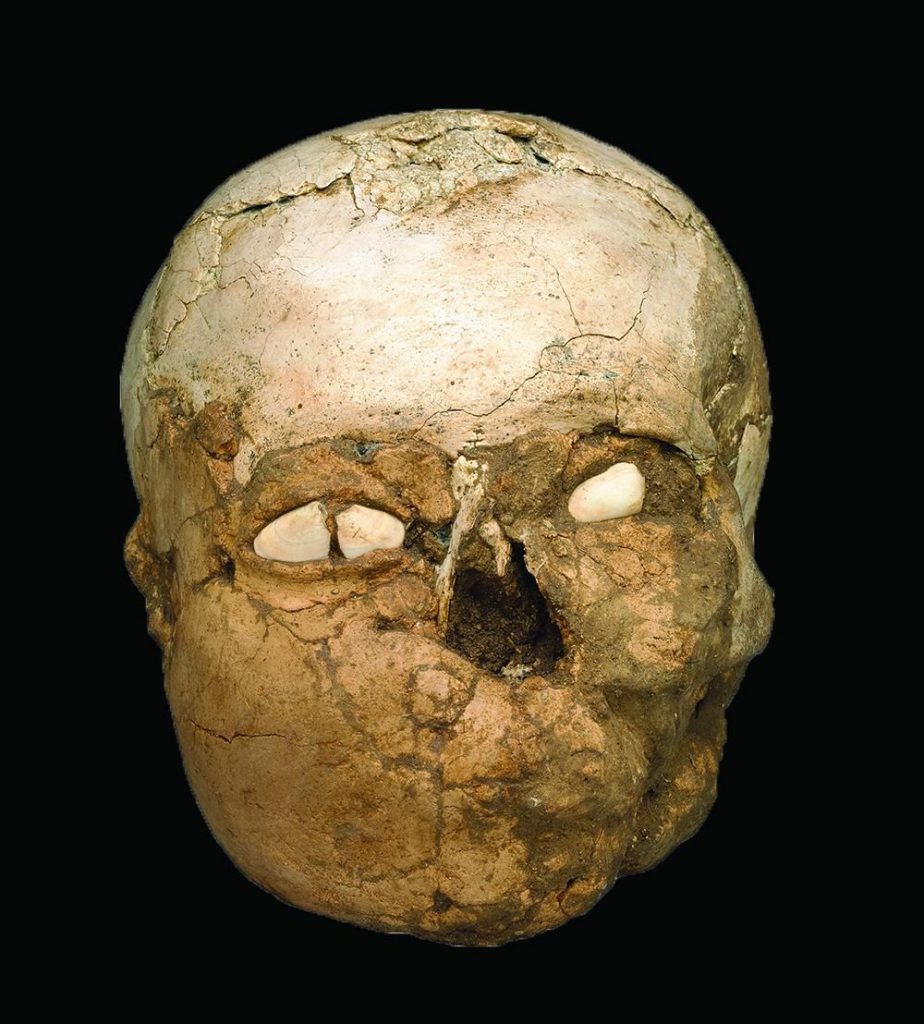
Handling the skull of his father is a key moment in the development of the young Emperor, giving him the inciting reason to begin inflicting his will on the world. He reaches out his mind and stops the heart of his uncle, his father’s killer (neither the first nor the last Cain and Abel reference in the Horus Heresy). With that, he has crossed the Rubicon and dived into changing the world around him. He journeys to Jericho and begins his work.
He began to help where he could, using his ancient wisdom to spread efficient government, crop management, animal husbandry, technology and peace. He always used his influence carefully, adopting the guise of a normal man, and without revealing his true nature.
Realm of Chaos – The Lost and the Damned
Notes: The idea of the Emperor as a gestalt entity of sorts was first introduced in the first edition book Realms of Chaos: The Lost and the Damned; the original lore around the Emperor in Rogue Trader just as him being born to mortal parents, developing powers at a young age, and staying hidden among humanity for a very long time until the year 30,000 or so. Lost and the Damned also places the Emperor’s birthplace specifically in Anatolia, so the idea of the Emperor being from that region has been canon pretty much forever.
Why? When we’re looking at lore, it’s important to look at the context it was written in. Warhammer 40k was written by British authors, so in looking for THE place to situate the origins of the Emperor, they’d draw on what they knew about (extremely) ancient history. Mesopotamia is occasionally referred to as the “cradle of civilisation” – the origins of European and Levantine agriculture, commerce, cities and, well, all the other things we associate with civilisation like hierarchy, massive communicable disease, and war. The Emperor bringing humanity civilisation out of Mesopotamia is very much in line with a lot of – now discredited – quasi-archaeological thinking in the 20th century, that complex hierarchical societies built around agriculture emerged solely from the land between the rivers. The Emperor is Mesopotamian because that’s where the authors would draw from when thinking about the first Kings and Emperors. In another version of 40k, written by people elsewhere in the world, he is perhaps Oaxacan, Pakistani, or Austronesian, hailing from any number of other cradles of human civilization.
Alternate Beginnings
One of the maxims of the 40k universe is that everything is true and none of it is accurate. There are hints that the Emperor is something very different – a bioengineered weapon from the apex of mankind’s long history of inadvisedly designed killing machines. With the Emperor coming to prominence at the end of the long Age of Strife/Old Night, striding out of the chaos of terra to impose a brutal, crushing order, it’s no wonder that his compatriots believed he was another impossible, man-made horror. Where this is said, there’s a clear and earnest belief that it is true, but as of yet we have no real textual evidence for it beyond hearsay – except from the mouth of another classic unreliable narrator in the 40k universe.
He is a relic left over from the Dark Age. A weapon left out of its box, now running rampant.
Koja Zhu, Master of Mankind – Aaron Dembski Bowden
When, tens of thousands of years after the supposed birth of the Emperor, Belisarius Cowl is poking around the Pharos device, he encounters a trapped shard of the Necron’s betrayer-gods, the C’tan. The C’tan elucidates on the nature of humanity in the 41st millennium and – most importantly – describes the Emperor as simply “a weapon”. You can read this either way – that the Emperor was a weapon of the Dark Ages, or that the Shamanic conclave successfully created one. With the further revelation that humanity was shaped and constructed by the great enemy of the C’tan, the Old Ones, the way is even thrown open to claim the Emperor as an Old One weapon, in the same way as the Eldar or the mighty Snotling. Whatever the interpretation, there’s little further evidence within the Black Library that the Emperor is a design from Old Night – perhaps more is to be revealed by the Harlequins.
Perpetual Striving
The Emperor was far from the only immortal offshoot of humankind in the mix – something he’d come to discover. Just as old were the Perpetuals, mutated humans who were born with preternatural abilities and immortality, able to heal from nearly any injury. Some of these are as old as the Emperor himself, and many were gifted with unique powers. Some shared the Emperor’s interest in guiding mankind to a better future (Malcador the Sigillite and Erda), while others tried to stay out of things (Ollanius Persson), and others were pretty vile. During his long life on Earth the Emperor would eventually attempt to locate every Perpetual and enlist them to his cause. Many would decline – and more than one major conflict in human history is said to be the result of a Perpetual attempting to throw off the Emperor’s grand plan. Those who joined the Emperor would stay with him a while but most eventually left, fed up with the Emperor’s arrogance and lack of patience for those around him who were less intelligent, skilled, or devoted to his cause.
What the Perpetuals have told us is that for 40,000 years, the Emperor has had a plan. Apparently. Ostensibly. At least, he says he had a plan. A being of the Warp, whether gestalt entity or immortal psyker, The Emperor has had long experience of the Chaos Gods and, in his telling, he plans to oppose them, to both provide Humanity’s shield against the warp and use us as a weapon against it. The plan would partially culminate in the Great Work we’ll cover below, but that kicks off in the 30th millennium. That means 40,000 years (10,000BCE give or take a few centuries up to 30,000CE) of doing… various bits and bobs. We could be charitable and believe Erda in Saturnine, the Emperor of a thousand plans, occasionally thwarted, or set back, or moving quicker and subtler than any competitor, rival or enemy, or we could think “maybe 40,000 years is too long for a plan concocted by humans writing about a super-human to be plausible”. Either way is fine.
Note: It’s also worth saying that 40 years of overlapping and occasionally conflicting accounts of the prehistory of 40k have left this a little muddled. What was once perhaps winked at, hinted or referenced, has been occasionally abandoned – and for good reason. Perhaps, in-universe, we can say that our poor 21st century brains simply can’t understand what the Emperor was up to and why it took him 40,000 years to accomplish very, very little until the end.
The Emperor may have almost lain dormant – a weapon concealed in his sheathe – while the Chaos Gods began to coalesce around human emotions and frailties in his early days. The Lost and the Damned has it that:
During the Emperor’s Youth and early life, the Chaos Powers were insufficiently strong to disturb the natural harmonies of the warp
As the Four grew in power – well, perhaps the Three, but time is a funny thing in the warp – the Emperor worked against them in many guises, providing the technological, spiritual, political and ethical leadership that he felt humanity needed to prosper. He took many forms and played many roles.
He travelled the entire globe, watching and helping, sometimes adopting the persona of a great leader or advisor. In times of trouble he became a crusader, a religious leader or messiah, at other times he remained a back-stage contributor to events, an advisor to Kings, a court magician, a pioneering scientist
Realm of Chaos – The Lost and the Damned
Notes: There’s a hint – if not a flat out statement – that the Emperor actually owns the book I’m taking this from. In The End and the Death Part 1, when Sindermann is flicking casually through the Emperor’s forbidden Library, what pops up?
The Emperor has long had some defined roles in human history, places where either new or well stablished lore has him taking a direct hand, but he has, at least in Malcador’s telling, had many that we don’t know of:
Over the millennia, he has worn many masks, each suitable to the task at hand. His mind, his greatest gift, allows him significant flexibility in such things. He has appeared as male or female, or neither, as child or elder, peasant or king, magician or fool. He has been an entire cartomantic arcana, for the Master of Mankind is also a master of disguise. He has performed all of these roles well, with delicacy. He has been humble when humility was needed, gentle when softness was the best device, sly, amiable, reassuring, commanding, caring. He has been terrible when terror was the only recourse, and sometimes meek in order to inherit the Earth. He has been whomever and whatever it has been necessary to be. No one has ever seen his true face, or learned his true name.
Dan Abnett – The End and the Death Volume 1
Note: “meek in order to inherit the Earth” is, at least to me, a direct reference to the Emperor being Christ (Matthew 5:5)- in which case, happy birthday, Emperor – but I have had a couple of debates about this over the year since this book came out, so I’m willing to concede I might be jumping to a conclusion there, however justified I feel it to be.
The Emperor’s foes are said to have fully awakened during the European Middle Ages but we know that the Emperor was certainly politically and militarily active in Mesopotamia for several thousand years. He was a warlord and a general working with fellow Perpetual Ollianus Persson, making him his first Warmaster, to assault and destroy a chaos-leaning project to master the forbidden language of creation, Enuncia. We know this project as the Biblical story of the Tower of Babylon – most likely itself originating from a much older Sumerian myth of the late Uruk period. With a little extrapolation, we can posit that the Emperor acted as the King of the mythical kingdom of Aratta (En-Suhgir-ana) to oppose Enmerkar’s Extended Duolingo Project, nicely situating him back in Anatolia.
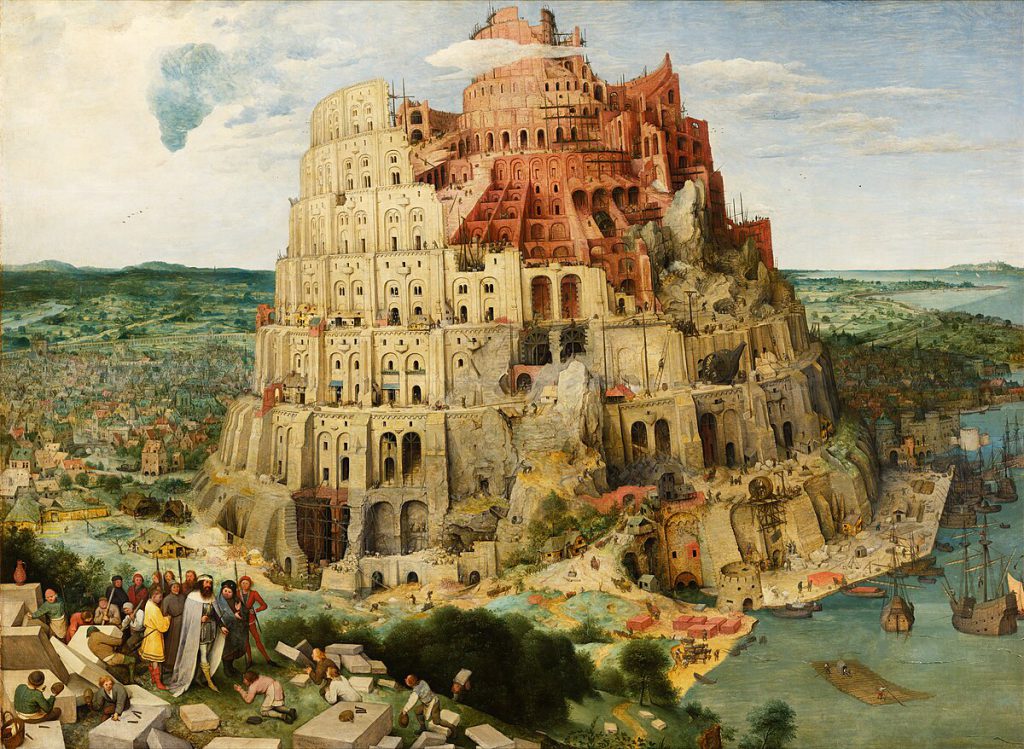
In around 356BCE, the Emperor manifested as a Macedonian General – or, at least, this is the birthdate of who Malcador would later claim as the Emperor, Alexander the Great. He launched a grand conquest of the Hellenic world, Persia, and India, created an Empire that lasted the best part a decade, and wept at the limits of his reach somewhere on the Beas river when his men would no longer follow him.
Notes: It’s tricky to understand what the Emperor wanted here – there’s definitely a eurocentric and undoubtedly pretty racist idea that “spreading Hellenic culture advanced world civilisation” angle that is occasionally advanced on the internet. When the Emperor in this guise “dies”, his Generals bicker, feud, and eventually go to war over the conquests, splitting the brief-and-never-quite-unified Empire into fragments. The Emperor-as-Alexander functions better as a metaphor for ambition, the blindness of leaders to the will and capability of their followers, and the fragility of empire, than it does as part of a great and epoch spanning plan, and that’s good, because the metaphor tells us something important and the history tells us little of use.
We gain snatches of knowledge of the Emperor’s work against Chaos during the long night of our own history. He confronts Gog, an eternal, recurring foe of Jewish, Christian, and Islamic myth. He puts his learnings from Babylon into good use, wielding Enuncia to end a major servant of the Four powers. Gog and Magog crop up in many mythic cycles, usually representing a powerful force outside of the realm of law and order – of small-c chaos. They’re also closely incorporated into the founding myths of London, and it’s no surprise then that Gog is killed in what will one day become Albia.
Another figure has entered the tower. Gold-armour plates cover the figure from his throat to his feet. A cloak of scarlet and orange ripples at his back. He wears no helm, though a crown of silver leaves and golden feathers circles his dark hair above a lean face.
Athame – John French

We can pick up the Emperor again in the 11th century, where does battle against the C’tan Mag’ladroth. The Emperor, in the guise of a Roman soldier, rides to confront the newly awakened Void Dragon, a shard of the shattered C’tan, in Libya. He rides out to confront the threat – presumably the threat to the Islamic Golden Age – and casts it down, imprisoning it deep under the sands of Mars, there to foster the growth of human technology, sowing the seeds of knowledge needed to cast humanity out into the stars.
Dalia almost wept at the sight of the Knight, a being of fairer presence than any she had seen, and one whose wonderous power was undimmed by the passage of years
Mechanicum- Graham McNeil
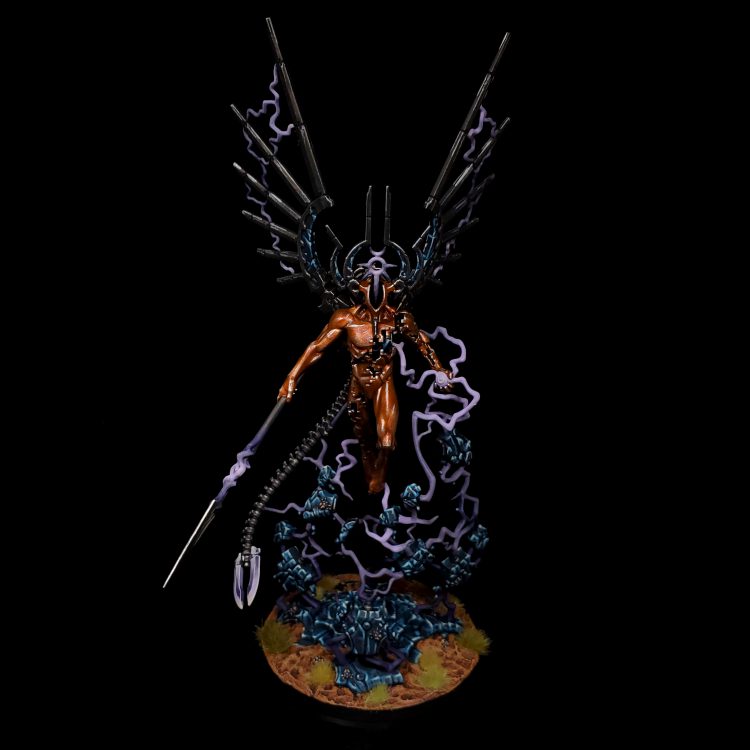
The tale would find its way into human parlance as George and the Dragon, interestingly also moving out from origins in Anatolia. After that, with the exception of poorly-thought-through lore hints long discarded, the Emperor goes dark.
The Webway
The Emperor was certainly up to something between the Middle Ages and the Age of Strife, but what it was isn’t exactly clear. The rise of Humanity from Earth to the Stars – the Age of Terra, the Age of Technology and the early part of the Age of Strife – all lie in our future, and where the Emperor takes humanity in that time is yet to be revealed. We know hints, mainly through Perpetuals and others who have enhanced their lifespan through unnatural, forbidden means:
Even then I could see what he would become. Your father, I mean. I knew what future awaited a man who dreamed the dreams he did. Though it took decades or centuries or longer, I knew he would not be denied.
Basilio Fo, Misbegotten – Dan Abnett
The Emperor foresaw the fall of the Eldar that would bring about the end of the Age of Strife. Was he trapped on Terra as the first human empire fell? Did he lend sword and armour to the war against the men of iron, the men of stone, the men of gold? What role did he play in shaping, or forcing, mankind’s evolution into a psychic species? We don’t know, and I hope we never do – some things are better left to mystery.
Note: This is where 40k lore begins to get a bit threadbare and thin, where slightly more modern takes are hamstrung by the fact that the chronology doesn’t particularly stand up to scrutiny and 40,000 years is an incredibly long time
What we can say is that the Fall of the Eldar opened the way for the final stage of the Emperor’s ineffable plan. In the last days of the Age of Strife, the Emperor undertakes the war of Unification, creating the Thunder Warriors to first carve out the nacent Terran empire and then expand it over the globe. Using naked force, diplomacy, espionage and the terrifying threat of his armies, warlords are overcome, nations crushed into history and, slowly and painfully, Terra is united under the lightning-and-eagle banner of the Emperor. Once it is, Union with Mars Beckons. All to enable the Emperor to enact his grand plan to shepherd humanity – The Great Work would commence.
We could go into a lot more detail here, but let’s be honest – you could just go read Chris Wraight’s Valdor, Birth of the Imperium, because otherwise we’d be quoting the whole thing.
The Emperor enacted his big plan during the Unification wars, one that aimed to bring Humanity back together and force them to undergo the next stage of human social evolution, freeing them from the grip of chaos as they transmuted into a species strong enough to resist, and destroy, the Gods. The Great Work is both the Great Crusade, where humanity will be gathered under the heel of a single leader, and the takeover of the Webway, a “safe” place to live, travel and work away from the major predators of the other side of reality. The Webway project begins on Terra long before the first time we, as readers, are introduced to it. It is centuries of work to build the Imperial Palace, construct what appears to be a brute-force entry into the Old One’s Webway network, and then to channel huge resources into mapping, controlling and upgrading it. We see the Great Work best in Aaron Dembski-Bowden’s Master of Mankind, a place haunted by the still-reeling Eldar, where the ingenuity of the Mechanicus and Emperor is slowly forcing human technology and lives into a place never intended to host them. If the Great Work can be completed, then Humanity can be free of the need to travel through the warp. In time, it can be cloistered in the infinite webway, there to evolve and prosper free of the influence of the Four Powers until the Emperor is ready to unleash his species to scour them from the Warp altogether. But something comes along and fucks it up, and ultimately, only the Emperor can be held responsible.
The Emperor looked upon him – His Son, His creation – with eyes that had seen countless suns and civilisations die.
“Magnus” He said.
“Father” breathed the avatar of burning misery in reply.
Master of Mankind – Aaron Dembski-Bowden

Notes: The Emperor’s big plan, in addition to his whole vibe in general, owes a huge debt to everyone’s favourite Sandworm, Duke Leto II, God-Emperor of Dune. In both cases an Immortal God-Emperor seeks to shepherd humanity past a potential outside threat by following their absolutely insane path at any and all costs. The differences are pretty small, and you can feel the sheer Herbert-ness coming off the Emperor at a thousand yards. Where Leto II seeks to put humanity beyond the grasp of precognition and to scatter us to the corners of the galaxy to ensure future survival against a concentrated threat, the Emperor gathers us together to survive a scattered one. Both seek to bring humanity through a period of genetic evolution and both use tyranny to do so. Turns out the Kwisatz Haderach was in Anatolia all along it’s just that the Bene Gesserit didn’t know to look.
The Modern Prometheus
If the Emperor was going to reconquer the galaxy, he’d need help, and he needed it from beings that were more refined and a bit less violent than the Thunder Warriors he’d used to retake Earth. What the Emperor wanted was an entire race of Perpetuals who, unlike the naturally born ones, were completely loyal and obedient. But building the perfect warriors he was looking for took resources he didn’t have – technology, know-how, and well, twenty perpetual embryos to genetically modify.
Those embryos came from the Perpetual Erda, arguably the most powerful of that particular bunch, who had met the Emperor way back before he was cool. She “offered up her gene stock” to the Emperor to combine with his for the Primarch project (cue eyebrow motions), and actually considered the primarchs to be her sons. When the Emperor prevented her from taking any part in their lives she got pretty pissed off (and also realized what a bleak future was in store for them as mere tools to be used for the Emperor’s war), and she turned on the Emperor, finally realizing that he’d always been kind of an arrogant dick.
The technology came from a variety of sources – Dark Age technology and (probably) that of the Selenar, a group of religious cultists with access to powerful genetic engineering technology who had settled on the Moon. While the Thunder Warriors had been created in the very crude conditions of a post-Age of Strife Earth, the Emperor built new, much more advanced laboratories for creating his new warriors and protected them with powerful Geller Fields to shield his work from the warp.
NOTHING THAT SAFEGUARDS HUMANITY CAN BE EVIL, NOT EVEN THE MOST STRENOUS INHUMANITY
The Emperor – Inquisitor, Ian Watson
Why build these, you ask? Well, that’s because of the forbidden knowledge used to create the primarchs. At some point prior to the creation of the Primarchs, the Emperor traveled to a world named Molech, where he traversed a chaos gate in order to have a private audience with the (at the time) three Chaos gods. There he struck some kind of bargain with them, the terms of which are unknown, trading for the special knowledge to create the primarchs and imbue them with warp energies and set them on their grand destinies. Whatever he offered up for this is unknown, but it’s made very clear in various books that the Chaos gods believe he did not deliver on his end and tried to cheat them (Note: Probably, but also the servants of the Chaos Gods who say this are liars and trying to persuade marines of their cause). It’s suggested that one or both of two things happened at this point: Either Erda was manipulated by Chaos into creating a warp vortex in the lab and/or some Word Bearers doing Time Travel shenanigans though the Eye of Terror destroyed the Geller Field generators. Either way, once the field went down a warp vortex opened up and sucked all twenty primarchs through it, scattering them across the galaxy. This pissed the Emperor off something fierce, and he knew Erda was involved, but chose to let her live, to everyone’s surprise.
Notes: The Primarchs are probably the single most changed bit of 40k lore over time. In the original lore of Realms of Chaos: The Lost and the Damned, they were genetically-enhanced super-humans with godlike powers, through whom the energy of the uncorrupted Warp could flow same as it did through him, giving them powers similar to those shamans of old. They also weren’t that big a deal, save for Horus – something that would change dramatically over time. The Primarchs really started being fleshed out in the lore in the 2nd edition Codex: Chaos Space Marines, which introduced (and named) each of the Chaos Legion primarchs, though made them much more mortal. Lore around this time actually suggested that some of the primarchs just died of natural causes in the thousand or so years following the Heresy. Basically, they were just some guys early on.
After the Primarchs were scattered, the Emperor didn’t really have the resources to build a new set so he decided to just move forward with the warriors he did have – the Adeptus Astartes, warriors created from the primarch’s gene stock. If the Primarchs were out there, he was going to find them. If not, he’d make do. That’s an important note here – unlike Erda, the Emperor emphatically did not think of the Primarchs as his sons (though he was happy to let them think of him as a father) – with one potential exception, as we’ll see.
The Golden Throne
We’ll leave the Great Crusade and the majority of the Horus Heresy to its own article – you can, if you like, go read about them via our guides to the Heresy series (Loyalist and Traitor). At the end of the Heresy, the Emperor is entombed onto the Golden Throne, but, since we’re here, the throne is worth thinking about.
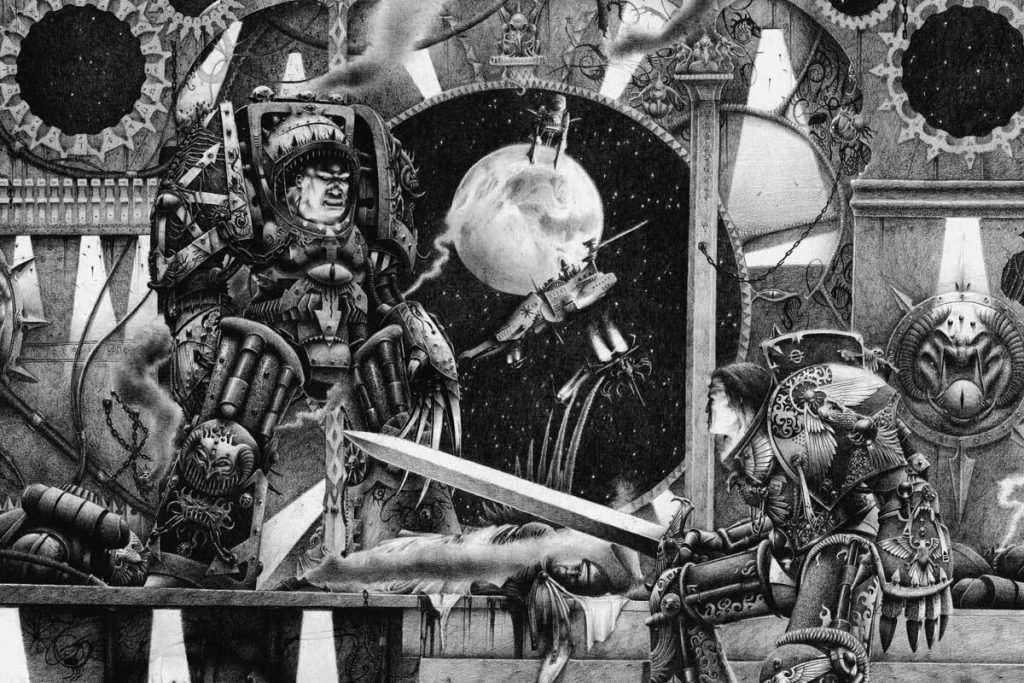
It’s important that it’s Dorn who places the Emperor in the throne, and that it always has been Dorn. Dorn is the preserver, the guardian – the Primarch who keeps things as they were, inviolate. Placing the Emperor in the throne is as close to defensive, political, spiritual and magical stasis as it is possible to get. Dorn keeps things as they are, and works to defend. Even with the Emperor broken and dying after his battle with Horus, there was much left to do to ensure the stability of the Imperium, and Golden Throne was part of that. It is not just a life support, but a containment field for the Power of the Emperor. At the height of the Siege of Terra, the Emperor draws on the power of the warp to such an extend that he begins the process of deification, transmuting his own (supposedly) near-human flesh into a being of pure warp energy, one who can not just stand face-to-face with Horus Ascended, but with the very Gods themselves. A fifth Chaos god, whose birth will mean the end of the real. He is heralded by prophecy and demon alike as The Dark King. While the Emperor gives up this power, dark and troubled hints suggest it was never in his ability to choose, or relinquish. Images of the Dark King immolated on a Throne of Skulls and/or Gold haunt the Library of Leng. Is the Emperor trapped on the throne for his sake? Or for humanity? What happens when the throne fails? Does he live, or die… or neither, and worse?
The Golden Throne has gone through as many iterations as editions of 40k. A combined life support device, psychic beacon, barrier against psychic incursion and – most importantly – sealing the infinite tear in the fabric of reality caused by the failure of the Webway project. The Throne is not a seat, but an infernal device of monstrous size and power, one that takes Malcador a couple of pages of The End and the Death Part 1 to describe. The life support function comes as a last-gasp to keep the Emperor alive, but more importantly to keep the Throne functional. Without it, Terra – and perhaps the whole Galaxy – is lost. It has a hundred conflicting purposes and descriptions, but at base we can say this: The Emperor is entombed within it, and it is failing.
The Throne has been failing for a long time. Flickers in power and breakdowns of mechanisms were detected in M36 and have only worsened. Inquisitorial factions have taken ever more extreme steps to analyse and right the mechanisms, and ever increasing numbers of psykers are fed into the machine to sustain the corpse entombed within.
Since his internment the Emperor has had to consume the souls of hundreds of psykers a day to sustain his existence, but it is said that his appetite for life force is becoming insatiable
Warhammer 40,000, Tenth Edition Rulebook
As of M39.999 the Mechanicus have discovered failure points in the mechanisms of the Throne that are far beyond their ability to repair, or even understand. Though the Avenging Son has returned, without the Emperor on the Throne madness, chaos, and war beyond even Guilliman’s ability to manage will be unleashed on the galaxy. It is only a matter of time before the final collapse of the throne, and only the Emperor knows what will happen then.
Notes: There’s an interesting (and changing) story when it comes to the level of consciousness the Emperor actually possesses on the Golden Throne. Original text around the topic in the first edition books Warhammer 40,0000: Rogue Trader and Realm of Chaos: Slaves to Darkness suggest heavily that the Emperor is still conscious and giving orders but slowly weakening as he loses a psychic battle against the Chaos gods. If we take the Inquisition War trilogy as canon – and we should, it’s damn cowardly to rule it out, for all that it’s a weird, pervy set of books – the Emperor is capable of carrying on full conversations as and when he likes. Newer texts make this much more ambiguous, suggesting the emperor may just be a corpse and any fragmented conversations with him may be be psychic at best and imagined at worst.
WE ARE THE ONLY SOURCE OF GOODNESS, SEVERE AND DRASTIC. THERE IS NO OTHER SOURCE OF HOPE THAN US. WE ARE AGONISINGLY ALONE
The Emperor – Inquisitor, Ian Watson
The Sensei and the Star Child
One important (and constantly changing) piece of lore in the 40k universe revolves around whether the Emperor ever had any children during his millennia on earth. Some sources – particularly older sources like the original Realms of Chaos: Slaves to Darkness from first edition contend that yes, he did, and these children were both immortal and imbued with their own psychic power, though they were also infertile and could sire no descendants of their own. These offspring were referred to as the Sensei. These beings often have no idea what they are until they come across some other Sensei, at which point they may be inducted into a brotherhood, preparing and training for a “last battle against Chaos.” Lost and the Damned would later change this a bit, making the Sensei the Emperor’s champions in the same way the Chaos Gods have theirs, marked with a piece of their power. The Sensei can ascend into quasi-demonhood, making them avatars of the will of the Emperor distributed in the Warp. Elements of this still exist in the 40k Universe, with the living saints of the Adepta Sororitas echoing much of the old Sensei lore.

Notes: The Sensei mostly seem to have been replaced in the lore by Perpetuals. Narratively they serve the same purpose of giving you very ancient, mysterious characters who Remember Things from the Before Times without being bogged down in the baggage of being blood-relations of the Emperor. I love the Sensei and the Star Child lore, it’s spectacular bits of high-fantasy hero with a thousand faces thrown into an ostensibly gritty Sci-fi universe, and we’re all a bit poorer for it’s loss.
Another being of dubious canonical validity, the Star Child refers to the psychic soul of the Emperor, untethered from his physical form. First introduced in Realms of Chaos: The Lost and the Damned, the idea is presented that when the Emperor died, his soul became one with the warp, causing his body to shrivel into a mummy and die. This uncorrupted essence now drifts in the Warp, where it waits for a moment to be reborn into a new human vessel, also (confusingly) referred to as the Star Child. In the meantime, the Star Child is theoretically the being through which human faith in the Emperor can be converted into power; the Star Child in that sense is akin to a fifth, more benevolent Chaos god.
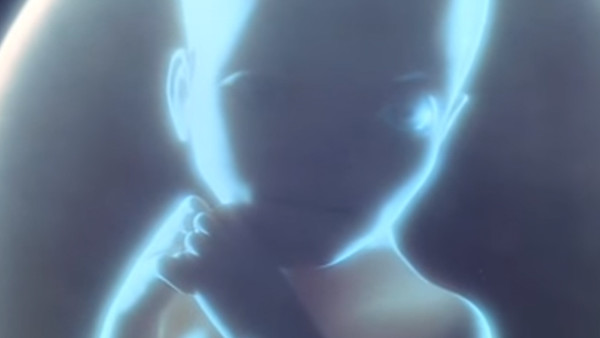
Notes: One of the last pieces of fiction in the Warhammer 40k 3rd edition rulebook marks the end of the Sensei and Star Child as a core aspect of 40k lore. Inquisitor Fortez hunts down and destroys a Star Child cult, killing a group of Sensei in the process. While nothing and no one in the 40k universe is ever truly canonically “correct”, it’s interesting that, immediately after Andy Chambers and Rick Priestley’s game design notes comes a lore statement – the Star Child and Sensei are a chaos cult, one that will be hunted to extinction, and alongside the in-universe purge comes a lore purge too.
For all that the Sensei and the Star Child seem to have been consigned to 1st and 2nd edition lore, these ideas have shown up in several key places in the 40k universe more recently – most notably in sources on the Inquisition, where the ideology of the Thorian faction is strongly tied to the idea that the Emperor can be resurrected into a new host body and this new Emperor can unite humanity. This belief is tied to the idea that at the time, it was obvious that Sebastian Thor was imbued with some measure of the Emperor’s Will and Charisma. What happens after the Emperor is reincarnated in this scenario is left as an exercise to the reader, presumably, but significant factions of the Inquisition – the Horusians and the Thorians – leave lots of room for the avatar-of-the-warp concept to play out in the future.
Most recently, the Star Child made a reappearance in 40k lore for the Indomitus Crusade (the Dawn of Fire books, specifically). Visions of the Star Child have popped up on Astropathic networks and in the minds of Imperial citizens. Also, some of the forces of Chaos (most notably Kor Phaeron) have begun to work against any kind of awakening of the Star Child, so they certainly seem to believe it’s a real threat. There’s also clearly something afoot with regard to the power of the Imperial Faith and its growing influence on the material world, as shown in the Psychic Awakening series and the events taking place in the Pariah Nexus.
The Emperor as Hero
After all that, one question remains: Is the Emperor supposed to be good? Is his plan supposed to be sensible? Does he care, or is he a bloodthirsty, ruthless tyrant? Are we supposed to know either way?
In the early days of 40k lore, we had a fairly simple answer to this – the Emperor was more or less unquestionably a “good guy”. His will shielded humanity, his soul fought chaos, his living death was in service of the species.
As we’ve gone on, however, the picture has become more complicated. Seeing the Emperor “in the flesh” in the Heresy novels has made him both more inhuman and more inhumane. He is a monster – that is unquestionable. He is a victim of human authors writing metahuman plans, so he occasionally seems startlingly foolish. But was his plan a good one? Is he an inhuman monster acting for our betterment, or for his own? Is he still the Dark King – and is the Dark King the path untaken, or the one trod for the last ten thousand years?
The Emperor is no hero, and those who cling to the image of the God-Emperor clad in gold are foolish in both 2 and 40k contexts. Whatever he has done, however rationalised, has led to a nightmare future and subjected his remains to eternal torment. His hubris, arrogance, his centralisation of power, lust for control and his deified flesh serve to speak to our own world as much as the grim dark future. The Emperor, trapped in a prison of his own literal and metaphorical making and ruling over the endless horror of the Imperium without thought, word, or deed, remains the most obvious, and potent, metaphor in 40k – the empty trap of strong-man politics, the argumentum ad absurdum of fascism and the hollowness of Empire.
Questions, comments, suggestions? Actually one of the Sensei and you have opinions on your dad? Contact@goonhammer.com or leave a comment below.
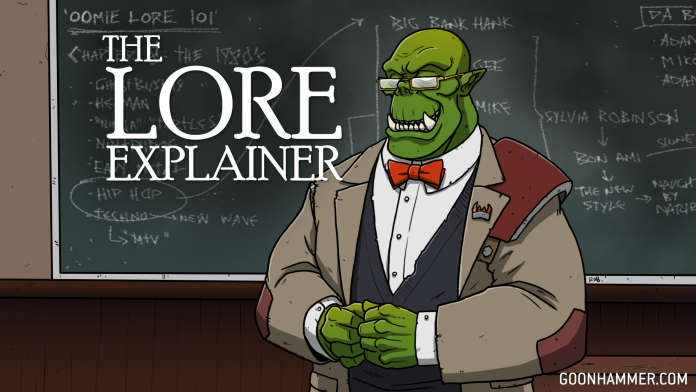


You must be logged in to post a comment.